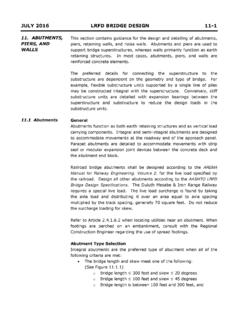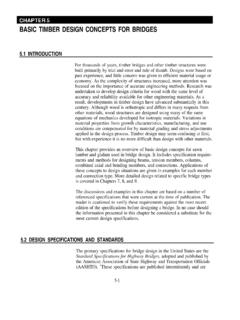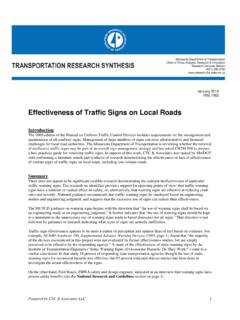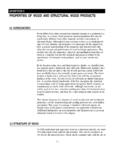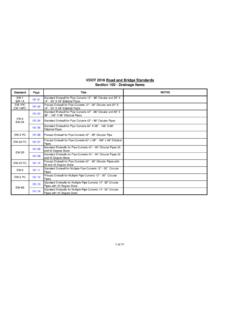Transcription of Fiscal Year 2016 through 2020 Bridge Preservation and ...
1 Bridge OFFICE minnesota department OF transportation Fiscal Year 2016 through 2020 Bridge Preservation and Improvement Guidelines Beverly Farraher Date Acting State Bridge Engineer Approved Table of Contents Page MNDOT Bridge ASSET MANAGEMENT .. 1 CHAPTER 1 GENERAL .. 2 INTRODUCTION .. 2 PURPOSE .. 2 SCOPE .. 3 CHAPTER 2 - PROJECT PLANNING AND PROGRAMMING .. 4 LONG RANGE PLANNING .. 4 STATE transportation IMPROVEMENT PLAN (STIP) .. 4 PROJECT PRIORITIZATION .. 4 MAP-21 REQUIREMENTS AND Bridge OFFICE CONDITION TARGETS .. 5 CHAPTER 3 - PROJECT DELIVERY .. 7 PROJECT DELIVERY PROCESS .. 7 SCOPING .. 7 ACCELERATED Bridge CONSTRUCTION (ABC) .. 8 Bridge REPAIR RECOMMENDATIONS .. 9 DESIGN .. 9 CHAPTER 4 - Bridge INVESTMENT CATEGORIES AND STRATEGIES .. 10 Preservation .. 10 IMPROVEMENT .. 11 Bridge INVESTMENT STRATEGY .. 12 Bridge PROJECT CLASSIFICATION .. 12 Bridge DECK WIDTH CONSIDERATIONS .. 12 CHAPTER 5 - Bridge Preservation .. 14 MAJOR Bridge Preservation ACTIVITIES.
2 14 CONDITION CRITERIA .. 15 COST CRITERIA .. 15 GENERAL GUIDELINES .. 15 STEEL 16 Bridge ELEMENT REQUIREMENTS .. 17 CHAPTER 6 - Bridge 18 Bridge REHABILITATION ACTIVITIES .. 18 CONDITION CRITERIA AND MINIMUM DESIGN .. 18 GEOMETRICS AND LOAD CAPACITY .. 19 CONDITION AND COST CRITERIA .. 20 GENERAL GUIDELINES .. 20 EXCLUSION FROM THE Bridge REHABILITATION MINIMUM GUIDELINES .. 20 GUIDELINES FOR Bridge DECKS .. 21 Bridge ORNAMENTAL TRAFFIC BARRIER AND CURBS .. 21 DESIGN EXCEPTIONS .. 21 Bridge ELEMENT REQUIREMENTS .. 22 CHAPTER 7 - Bridge REPLACEMENT .. 25 CONDITION AND COST CRITERIA .. 25 GENERAL GUIDANCE .. 25 CHAPTER 8 - Bridge ELEMENTS .. 26 BARRIER AND END 26 Bridge DECKS AND DECK PROTECTIVE SYSTEMS .. 26 PIER PROTECTION .. 26 LIMITS OF CONCRETE REMOVAL .. 27 LOAD FACTOR RATINGS (LFR) AND LOAD AND RESISTANCE FACTOR RATINGS (LRFR) .. 28 PRESTRESSED BEAM CONCRETE SHEAR .. 29 RETROFIT OR REPLACEMENT OF FATIGUE PRONE COMPONENTS .. 29 FRACTURE CRITICAL BRIDGES.
3 30 Table of Contents Page ASBESTOS AND REGULATED WASTE ASSESSMENT .. 30 HISTORIC BRIDGES .. 30 TYPE W Bridge CULVERTS .. 31 PEDESTRIAN ACCOMMODATIONS PER THE AMERICANS WITH DISABILITIES ACT (ADA) .. 31 CHAPTER 9 - Bridge BARRIER AND ENDPOST .. 33 NEW BARRIERS .. 33 IN-PLACE BARRIERS .. 33 END POSTS .. 34 CHAPTER 10 Bridge DECK GUIDANCE .. 35 GUIDELINES FOR Bridge MAINTENANCE .. 35 GUIDELINES FOR Bridge DECK REPAIRS .. 35 Bridge DECK OVERLAYS .. 37 REPLACEMENT OF IN-PLACE DECK PROTECTIVE SYSTEMS .. 37 LIMITED SERVICE OVERLAYS .. 37 CONCRETE OVERLAYS .. 37 POLYMER OVERLAYS .. 37 EVOLUTION OF PAST MNDOT Bridge DECK PRACTICES .. 38 FORMS .. 39 Bridge SCOPING AND COST ESTIMATE .. 40 Bridge RECOMMENDATION FIELD DATA .. 42 Bridge REPAIR RECOMMENDATIONS .. 43 Bridge PAINT RECOMMENDATIONS .. 46 Bridge DESIGN EXCEPTION FORM .. 50 ACRONYM AND DEFINITION .. 53 Time MnDOT Bridge ASSET MANAGEMENT Phase Action Who/What Operation All TH bridges Perform safety inspections Reactive & preventive maintenance Over-legal permitting and damage repair Bridge Data Management/SIMS Bridge load ratings Statewide performance targets Bridge condition and appraisal rating submitted to FHWA Bridge Office support District owned assets District Bridge Engineer manager BRIM ( Bridge Replacement Improvement Management) Identify Bridge service interruption risks with BPI ( Bridge Performance Index) Probability based on past performance, condition, and details Predict future repairs and conditions Basis for 20 year plan and HIP (Highway Improvement Plan) 10 year plan Perform field reviews to assess needs Bridge Office generates BRIM District review and comment STIP (Statewide transportation Improvement Program) Prioritize projects using National Highway Performance Program (NHPP)
4 Statewide Performance Program (SPP) District Risk Management Program (DRMP) Scoping level cost estimates 4 year program ABC projects identified Stakeholder collaboration Bridge Office manages SPP District prepares DRMP Bridge Repair Recommendation/ Bridge Preliminary Plan District approved Statewide consistency Innovation Minimum safety requirements Finalized 1 year prior to letting Design exception process Regional Bridge Construction Engineer develops repair recommendation Major Preservation Rehabilitation Bridge Preliminary Plans develops preliminary plan for replacements Plan Development AASHTO LRFD specification and MnDOT Bridge Design Manual Coordination with District grading plan Engineer estimate Bridge Office prepared Bridge plan and special provision District prepared grading plan and special provision Letting and Construction Bridge and approach construction District PM for project Bridge Office support throughout construction Operation Back to top
5 Scoping Planning Operation Ops Design Con . Bridge Preservation and Improvement Guidelines 1 CHAPTER 1 GENERAL INTRODUCTION There are approximately 4,600 bridges on minnesota s state highway system. These bridges were built over the course of many decades and are variable in type, size, material, design details, construction methods, and service conditions. Despite this variability, most bridges can remain in service for 60 to 100 years if the proper investments are made in Preservation and improvement throughout the life of the Bridge . minnesota s bridges are managed with a focus on assuring public safety and minimizing lifecycle costs. With a fiscally constrained budget and competing transportation needs, it is difficult to efficiently optimize Bridge investments. However, a systematic approach to planning and performing Bridge Preservation , rehabilitation and eventual replacement projects will keep our system of bridges structurally sound while maximizing their service life.
6 PURPOSE These guidelines are established to assist Bridge Office and District personnel in identifying and prioritizing Bridge Preservation and improvement needs. They provide standard definitions and a basis for consistent decision making. The Federal Highway Administration (FHWA) Bridge Preservation Guide was used as a reference in developing these guidelines. Appropriate Bridge design standards are established based on investment level, along with expected outcomes in terms of slowed deterioration, improved condition, or service life extension. A design exception process is identified for situations when it is not prudent or feasible to meet applicable standards. Bridge Preservation and Improvement Guidelines 2 Guidance for Bridge project scoping is provided, along with requirements and guidelines for the repair or reconstruction of critical Bridge elements. These guidelines are consistent with the minnesota State Highway Investment Plan (MnSHIP) and current investment guidance provided within the Statewide Performance Program (SPP) and the District Risk Management Program (DRMP) based on requirements set forth in MAP-21 (Federal transportation Bill of 2012).
7 These guidelines are based on past experience and performance data. This document will be periodically updated as new data becomes available and new Bridge design and construction technologies are implemented. SCOPE These guidelines apply to the management of MnDOT s Bridge system but local agency Bridge owners are encouraged to follow these guidelines when planning and scoping their Bridge investments. The guidelines are primarily targeted toward activities that are performed under a construction contract. Major Preservation or rehabilitation projects performed by MnDOT District Maintenance staff are encouraged to meet similar guidelines. Detailed guidance on Bridge maintenance (preventive and reactive) is not included in this document. MnDOT s Bridge Maintenance Manual contains comprehensive information on Bridge maintenance management. This document contains certain requirements (including requirements on decks, barriers, fatigue prone components, and pier protection), and minimum design criteria applicable to major Preservation and rehabilitation projects.
8 Additional criteria, including current Bridge design standards, are found in MnDOT s LRFD Bridge Design Manual. The repair or extension of Bridge culvert structures is exempt from these guidelines except that special structural considerations for repair or extension of Type W concrete box culverts are provided. Bridge Preservation and Improvement Guidelines 3 CHAPTER 2 - PROJECT PLANNING AND PROGRAMMING LONG RANGE PLANNING minnesota 's Statewide Multimodal transportation Plan establishes overarching guidance and priorities for making decisions across all transportation modes. This plan is focused on investment strategies over the next 20 years and is updated every four years. The minnesota State Highway Investment Plan (MnSHIP) links the policies and strategies laid out in the Statewide Multimodal transportation Plan to capital improvements on the state highway system. It is also a 20 year plan and is updated every four years.
9 Statewide Bridge investment needs are determined and documented in MnSHIP. These needs are established with the goal of achieving Bridge condition performance targets on the principal and non-principal arterial highway systems. Needs within MnSHIP are identified in terms of dollars of investment and the plan does not include the identification of specific Bridge projects. However, the basis for determining Bridge investment needs is the Bridge Replacement and Improvement Management system (BRIM), which identifies specific bridges and work types in addition to estimated costs in terms of a predicted risk of service interruption. BRIM analyzes Bridge inspection and inventory data to predict the replacement or improvement needs for each Bridge based on expected deterioration. BRIM then uses risk assessment methods to determine the Bridge s probability of a service interruption and the potential user consequences in order to establish a Bridge Planning Index (BPI).
10 Based on the BPI and input from District Bridge and Planning staff, a candidate list of bridges and work types is produced for HIP and STIP planning periods. This list provides the basis for more refined scoping efforts as individual Bridge projects move from the planning phase into programming. STATE transportation IMPROVEMENT PLAN (STIP) The State transportation Improvement Plan (STIP) is a federally required document that lists transportation projects that are expected to be funded within a four-year window. This list of projects includes state and local transportation projects funded with federal highway or federal transit funds. minnesota also includes projects on the state trunk highway system in the STIP, regardless of funding source (federal or state). The District programs their STIP based on input from the Area transportation Partnerships (ATP) through public participation and each ATP s draft Area transportation Improvement Program (ATIP), guidance and investment documents, and MnSHIP.

